Bhutan, a country known for its deep cultural heritage and spiritual legacy, hosts a variety of museums that encapsulate its rich history and vibrant traditions. These museums range from the National Museum in Paro, which showcases Bhutanese art and artifacts, to the Folk Heritage Museum in Thimphu, offering insights into the traditional Bhutanese way of life. Each museum provides visitors with a unique perspective on Bhutan’s past and present, making them must-visit destinations for anyone keen to understand the country's deep-rooted customs and artistry. Whether it’s exploring ancient textiles at the Bhutan Textile Museum or learning about Bhutan's royal history at the Royal Heritage Museum in Trongsa, Bhutan’s museums serve as gateways to exploring the country's intricate cultural tapestry.
At Amen Bhutan Tours and Treks, we pride ourselves on being the best company for exploring the rich tapestry of museums in Bhutan. Our expertly curated tours are designed to immerse you in the deep cultural heritage and spiritual legacy of Bhutan, providing unparalleled access to some of the most prestigious museums in the country, including the National Museum in Paro and the Folk Heritage Museum in Thimphu. With Amen Bhutan Tours and Treks, you will gain insightful narratives and deeper understanding not just of the artifacts and exhibitions but of the Bhutanese way of life. Join us to explore the Bhutan Textile Museum, Royal Heritage Museum in Trongsa, and many others, where every exhibit tells a story of tradition and artistry meticulously preserved through generations.
National Museum of Bhutan (Paro Ta Dzong)
The National Museum of Bhutan (Paro Ta Dzong) is an essential cultural landmark located in Paro, Bhutan. Originally constructed in 1649 as a watchtower to defend the Paro Dzong below, it was converted into a museum in 1968, under the command of the third King of Bhutan. This cylindrical building, which mirrors the shape of a conch shell, is one of the finest examples of Bhutanese architecture and stands as a prominent feature overlooking the Paro valley.
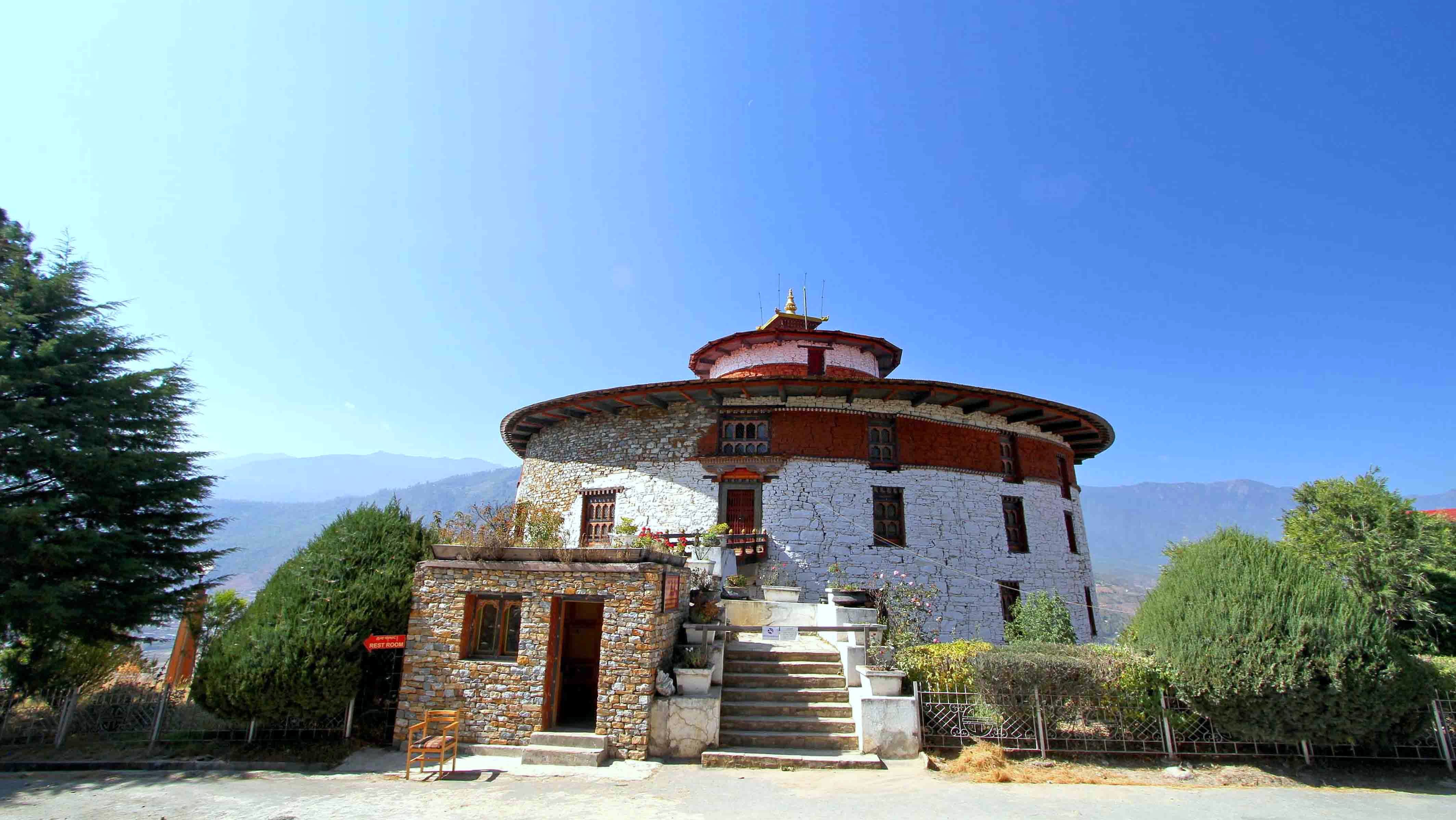
- Architectural Design: The unique circular construction provides panoramic views of the surrounding valley and serves as a natural enhancement for displaying the artifacts beautifully.
- Artifact Collection: The museum houses more than 3,000 Bhutanese artifacts from the 4000-year-old history of Bhutan, ranging from heritage textiles, paintings, and statues to weaponry and household items. Each artifact is meticulously preserved, showcasing the rich cultural and religious history of the kingdom.
- Thangka Paintings: Among the prized possessions are exquisite thangka paintings, which are religious Tibetan Buddhist paintings on cotton or silk appliqué. These paintings depict various aspects of Bhutanese culture and religion and are revered for their spiritual significance as well as their artistic beauty.
- Natural History Exhibition: There’s also a significant section dedicated to Bhutan's natural history, featuring a collection of Bhutanese flora and fauna, including a variety of stuffed birds and animals indigenous to the country.
- Philatelic Display: The museum boasts an impressive collection of Bhutanese stamps, which are world-renowned for their unique designs, including 3D images and recordable sounds.
- Special Exhibitions and Events: The museum frequently hosts special exhibitions and cultural events that dive deeper into specific aspects of Bhutanese heritage, offering visitors a chance to engage with local history and art on a more interactive level.
- Educational Programs: It also runs educational programs aimed at preserving Bhutanese cultural heritage, promoting it among the younger generations, and making it accessible to a global audience.
Visiting the National Museum of Bhutan provides a window into the soul of Bhutanese civilization, encapsulating its historical, artistic, and spiritual traditions. It remains a must-visit for anyone wanting to understand the depth and breadth of Bhutanese culture and history.
Folk Heritage Museum (Phelchey Toenkhyim)
The Folk Heritage Museum (Phelchey Toenkhyim), located in Thimphu, Bhutan, offers a fascinating glimpse into traditional Bhutanese lifestyle, agricultural practices, folk heritage, and rural traditions. Established in 2001, the museum is designed to connect visitors with Bhutan's past, showcasing how Bhutanese rural families lived in harmony with their environment using age-old practices that are still relevant today.
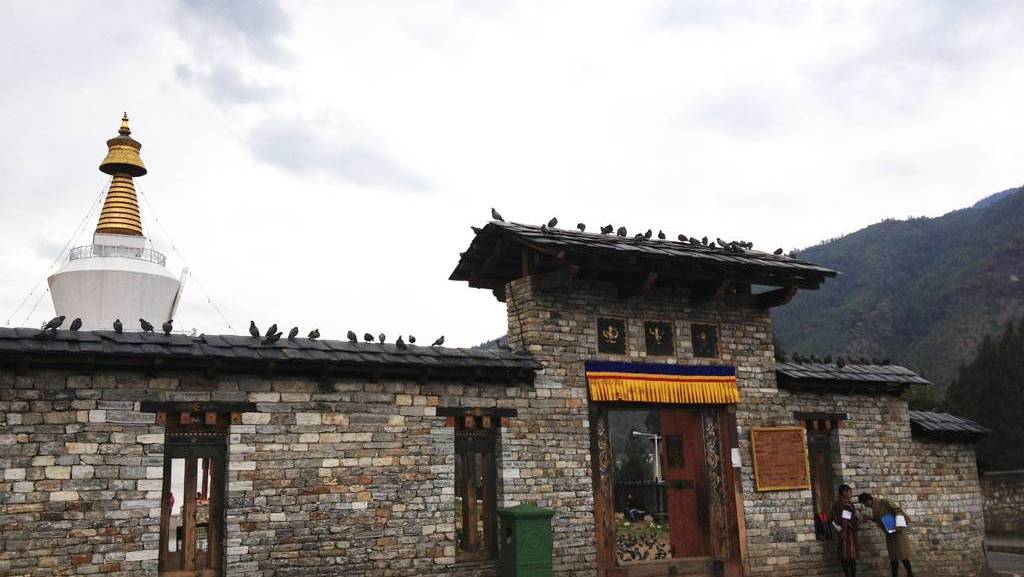
- Traditional Bhutanese House: The museum itself is set within a three-story, traditional rammed earth house. The building is over 150 years old and has been maintained to reflect the authentic rural settings typical of a Bhutanese household centuries ago.
- Exhibits and Artifacts: Inside, the museum displays an array of typical household objects, tools, and equipment used by Bhutanese families in the past, providing a tangible connection to the ways in which daily life was conducted.
- Cultural Demonstrations: The museum not only showcases artifacts but also offers demonstrations of rural traditions, such as the preparation of traditional foods, brewing of local beverages like ara (a traditional alcohol), and practices like milking cows and churning butter. These activities provide an interactive experience for visitors.
- Agricultural Practices: There is a focus on traditional farming tools and the types of crops that were historically grown in Bhutan. This part of the exhibit emphasizes the agricultural background of the country and its significance in sustaining the Bhutanese way of life.
- Seasonal Activities: The museum also highlights seasonal rural activities and religious practices, connecting them with the annual agricultural cycle, which is central to rural life in Bhutan.
- Educational Programs: It hosts educational programs for students and researchers interested in learning about Bhutan's folk heritage and the adaptation of ancient practices in modern times.
- Heritage Garden: Surrounding the museum is a heritage garden which contains native plants and trees that are used in daily Bhutanese life, either for culinary, medicinal, or religious purposes.
The Folk Heritage Museum not only preserves but also animates the rich cultural tapestry of Bhutanese rural history. It serves as an invaluable resource for understanding how the past has shaped the present and offers insights into the sustainable lifestyles of Bhutan's ancestors. This museum is a treasure trove for anyone interested in the deep-rooted traditions and the sustainable way of life of the Bhutanese people.
Textile Museum
The Textile Museum in Thimphu, Bhutan, is dedicated to preserving and promoting the rich textile arts of Bhutan, showcasing the country's achievements in weaving, which is considered one of its most important forms of traditional art. Since its establishment in 2001, under the patronage of Her Majesty the Queen Mother Sangay Choden Wangchuck, the museum has played a crucial role in sustaining and revitalizing the textile crafts that are a core component of Bhutanese cultural identity.
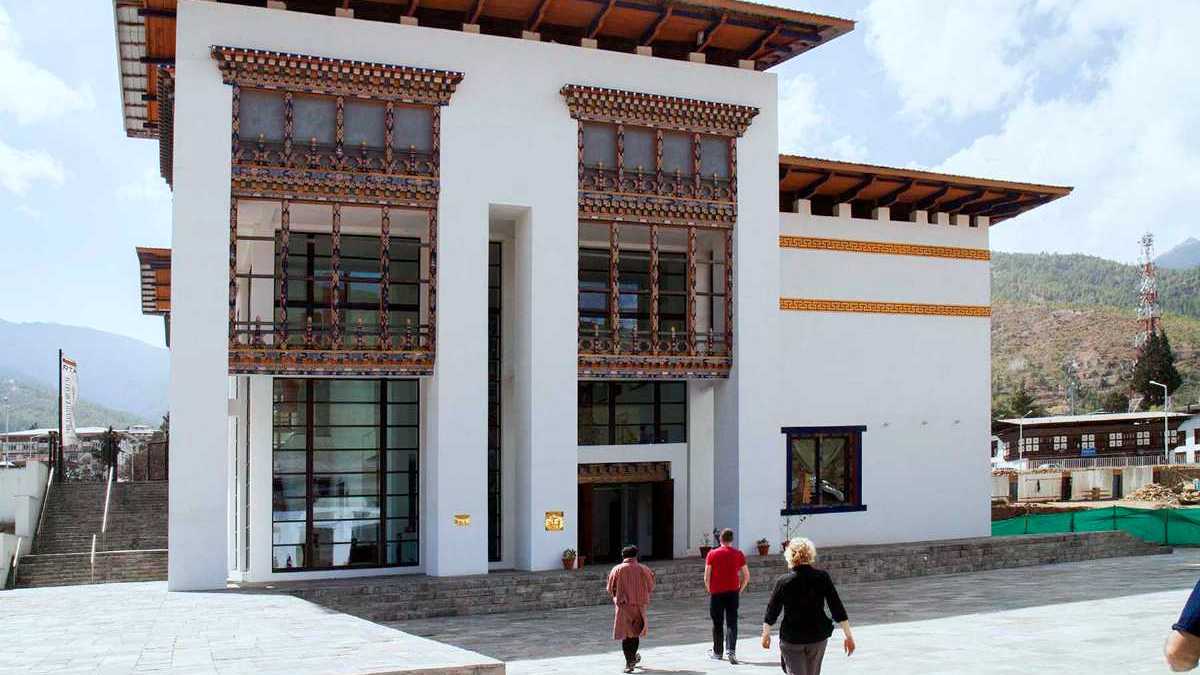
- Exquisite Collection: The museum houses an extensive array of Bhutanese textiles that are noteworthy for their artistic merit, intricacy, and the diverse techniques used in their creation. These textiles range from traditional garments like the Gho and Kira, which are the national dress for men and women respectively, to royal ghos and ceremonial crowns adorned with pearls and other precious items.
- Weaving Techniques: One of the main exhibits features the various weaving techniques used across different regions of Bhutan, demonstrating how the style and complexity of weave vary from one district to another. These include intricate brocades and the unique supplementary warp weaves of Kushuthara.
- Live Demonstrations: The museum not only displays finished products but also often hosts live demonstrations where visitors can watch artisans at work, weaving complex designs on traditional back-strap and frame looms. This provides insight into the skill and patience required to produce each piece.
- Educational Outreach: The Textile Museum conducts workshops, seminars, and educational programs aimed at teaching the younger generation about the traditional arts. These programs help ensure that the knowledge and skills of weaving are passed down and preserved.
- Cultural Significance: Each textile piece tells a story, reflecting the spiritual beliefs, social values, and historical context of its time. The museum carefully curates these stories, explaining the symbolic meanings of patterns, colors, and the occasions for which different textiles are used.
- Royal Textiles: The museum also features an exclusive gallery dedicated to the royal collection, showcasing garments and textiles that have been used by the royal family of Bhutan over generations.
- Conservation Efforts: Given the delicate nature of textiles, the museum is also involved in conservation efforts to ensure that these cultural treasures are preserved for future generations. This includes maintaining optimal conditions within the museum and restoring aged fabrics.
The Textile Museum in Bhutan is more than a repository of fabrics; it is a vibrant center that celebrates and breathes life into the ancient practices of Bhutanese weaving. It serves as a testament to the rich cultural tapestry of Bhutan and is a must-visit for anyone interested in the art of textiles and the broader cultural narratives woven into the very fabric of Bhutanese society.
Royal Heritage Museum
The Royal Heritage Museum in Trongsa, Bhutan, is a significant cultural institution dedicated to preserving and showcasing the rich heritage of the Bhutanese monarchy. Located in the ancient watchtower of the Trongsa Dzong, one of the largest and most impressive dzongs in Bhutan, the museum is strategically positioned on the ancient routes that connect eastern and western Bhutan, symbolizing its historical importance in the consolidation of the kingdom.

- Historical Location: The museum itself is housed in the watchtower (ta dzong) of Trongsa Dzong, providing visitors with not only historical artifacts but also breathtaking views of the surrounding valleys and the dzong itself, which has been a seat of power for many of Bhutan's kings.
- Royal Artifacts: The museum boasts a rich collection of artifacts associated with the royal family, including royal robes, crowns, and personal belongings of the Kings of Bhutan. Each item offers a glimpse into the lives and reigns of the monarchs, illustrating the evolution of the monarchy over time.
- Buddhist Relics: A significant portion of the collection includes religious relics, ancient manuscripts, and ceremonial items that underscore the deep intertwining of the monarchy with Vajrayana Buddhism in Bhutan.
- Interactive Displays: The museum features modern and interactive displays that engage visitors in the history being presented. These include audio-visual presentations and detailed plaques that tell the stories behind the artifacts.
- Raven Crown: Among the most notable items on display is the Raven Crown, which is the official crown worn by the King of Bhutan. This crown is adorned with a raven’s head, symbolizing the protective deity of Bhutan, Gonpo Jarodonchen (Mahakala with a raven's head).
- Photographic Exhibition: There is also an extensive photographic exhibition that depicts the historical events involving the royal family and major developmental milestones of the nation under their leadership.
- Educational Programs: The museum serves as an educational resource, offering guided tours and educational materials that help school groups and visitors understand the significant role of the monarchy in Bhutan’s development.
- Cultural Events: The museum frequently hosts cultural events and exhibitions that highlight various aspects of Bhutanese culture and history, further enriching the visitor experience.
The Royal Heritage Museum not only preserves the artifacts of Bhutan’s royal history but also celebrates the cultural and spiritual legacy of the Bhutanese monarchy. It offers visitors a profound insight into the pivotal role the royal family has played in shaping the history and identity of Bhutan, making it an essential visit for anyone interested in the heritage and governance of this unique Himalayan kingdom.
Bhutan Postal Museum
The Bhutan Postal Museum in Thimphu, Bhutan, is a vibrant celebration of the kingdom's innovative approach to philately and postal services. Opened in 2015 to commemorate the 60th birth anniversary of the Fourth King of Bhutan, Jigme Singye Wangchuck, this museum highlights the historical development of the postal system in Bhutan and showcases its unique collection of stamps, which are renowned worldwide for their creativity and innovation.
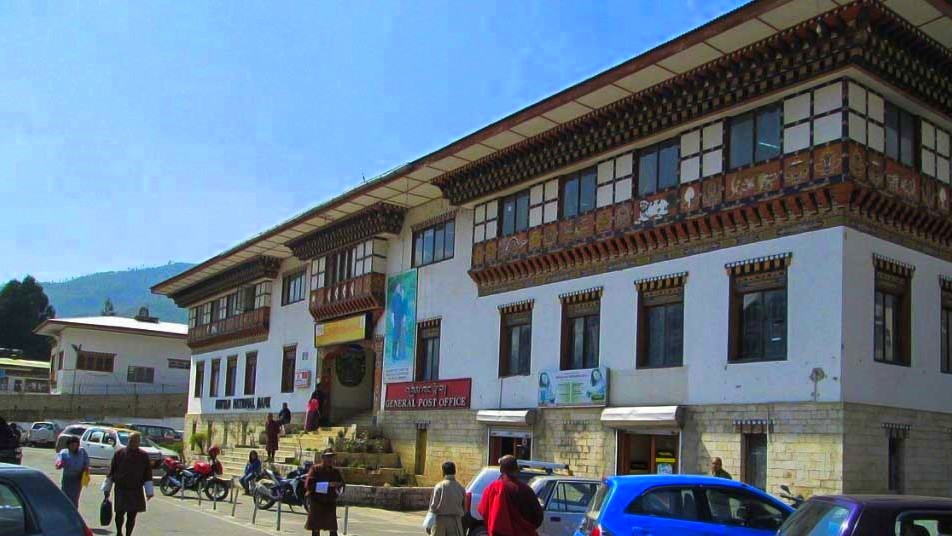
- Innovative Stamps: Bhutan is famous for producing some of the world’s most unusual and innovative stamps. The museum displays a wide range of these, including 3D stamps, talking stamps, and even CD-ROM stamps, which reflect Bhutan’s unique approach to philately that blends traditional themes with modern technology.
- Historical Narratives: The museum tells the story of the evolution of communication and postal services in Bhutan, tracing back to the earliest mail runners to the modern postal system. It highlights how these services have connected the remote Himalayan kingdom internally and with the wider world.
- Interactive Exhibits: Visitors to the museum can enjoy interactive displays that make the history of Bhutanese postal services engaging and accessible. This includes hands-on exhibits where visitors can create their own stamps, offering a personalized souvenir of their visit.
- Educational Outreach: The museum serves as an educational platform, particularly for younger visitors, to learn about the significance of communication in nation-building and the innovative spirit of Bhutan’s postal history.
- Cultural Insights: The stamps displayed provide insights into Bhutanese culture, showcasing themes from Bhutanese folklore, mythology, wildlife, and the royal family, which offer a window into the country's rich cultural tapestry.
- Philatelic Shop: For enthusiasts and collectors, the museum’s philatelic shop offers a variety of stamps for purchase. These stamps are not only collectible items but are also considered miniature pieces of art.
- Special Exhibitions: The museum also hosts special exhibitions and releases new stamps frequently, which keeps the content fresh and gives repeat visitors something new to look forward to.
The Bhutan Postal Museum is more than just a showcase of stamps; it is a testament to Bhutan’s creative engagement with its cultural heritage and modern technology in the field of philately. It offers a unique perspective on how a traditional service like the postal system can play a role in the cultural and technological advancement of a country. For anyone visiting Thimphu, a stop at this museum provides a delightful and enlightening experience into a lesser-known facet of Bhutanese innovation and artistry.
Simply Bhutan
Simply Bhutan in Thimphu is a distinctive and engaging living museum that offers visitors a unique and immersive experience into Bhutanese culture and tradition. More than just a museum, Simply Bhutan is an interactive cultural center designed to preserve and showcase the heritage of Bhutan while actively engaging visitors in a variety of traditional Bhutanese activities.
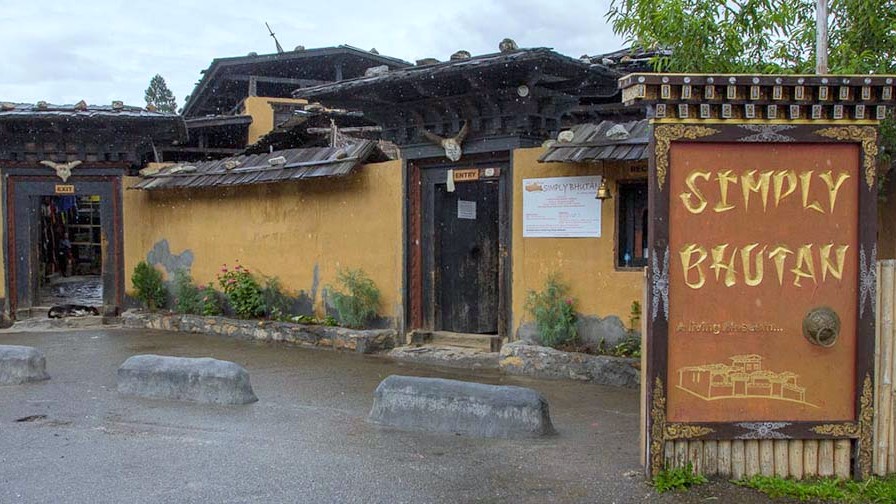
- Interactive Cultural Experience: One of the core attractions of Simply Bhutan is its interactive setup. Visitors can dress in traditional Bhutanese attire, try their hand at archery (Bhutan’s national sport), and even participate in traditional dances. These hands-on activities are guided by friendly staff, providing a warm and authentic introduction to Bhutanese culture.
- Traditional Bhutanese Architecture: The museum is constructed using traditional Bhutanese architectural methods and styles, featuring rammed earth walls and intricately painted woodwork. This setting not only reflects Bhutanese aesthetic values but also serves as an educational resource about the traditional building techniques that are a key aspect of Bhutan’s cultural heritage.
- Photography and Art Displays: Throughout the venue, there are various displays of Bhutanese art and photography that depict everyday life in Bhutan, as well as the country's picturesque landscapes and historical sites. These exhibits provide a deeper understanding of the cultural context and aesthetic sensibilities of the Bhutanese people.
- Culinary Experience: Simply Bhutan also offers a taste of Bhutanese cuisine, with traditional dishes prepared and served in the on-site restaurant. Visitors can enjoy authentic flavors made from locally sourced ingredients, providing a culinary journey through Bhutan’s gastronomic landscape.
- Cultural Performances: The museum hosts regular cultural performances, including traditional Bhutanese music and dance. These performances are not only entertaining but also serve as a dynamic way to learn about and appreciate Bhutanese performing arts.
- Souvenir Shop: At the end of the tour, visitors have the opportunity to purchase handmade crafts, textiles, and other souvenirs at the museum’s gift shop. These items are typically crafted by local artisans and represent another facet of Bhutanese cultural heritage.
- Educational Outreach: Simply Bhutan is committed to educating both locals and tourists about the importance of preserving Bhutanese culture. It hosts educational programs and workshops that aim to instill a sense of pride and continuity in Bhutanese traditions among the younger generations.
Simply Bhutan provides an extensive, all-encompassing experience that goes beyond the conventional museum visit. It's an excellent way for visitors of all ages to actively participate in, learn about, and appreciate the rich cultural tapestry of Bhutan, making it a must-visit destination for anyone traveling to Thimphu.
Tower of Trongsa Museum
The Tower of Trongsa Museum is a cultural highlight situated in the historic watchtower of Trongsa Dzong, one of Bhutan's most prominent dzongs, located in the heart of the country. This museum, also known as Ta Dzong, was established to preserve and showcase the rich cultural heritage of Bhutan, with a particular focus on the royal family and their governance that has historically been centered around Trongsa Dzong.
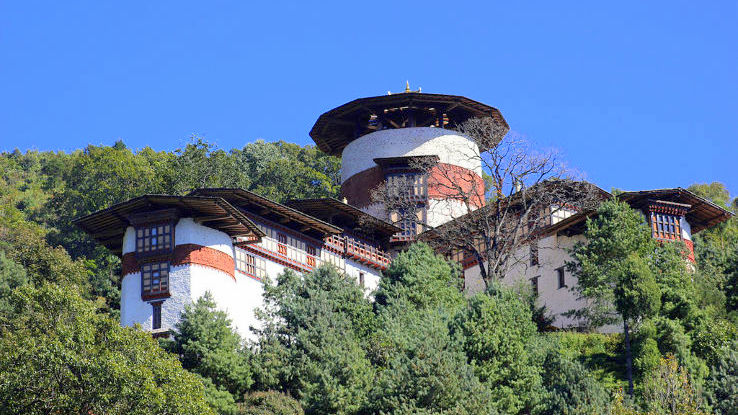
- Strategic Location: Positioned on a high ridge, the museum offers stunning views of the Trongsa Dzong and the surrounding valleys. Its location is historically significant as Trongsa Dzong was considered the vanguard of the kingdom, controlling the central and eastern regions.
- Architectural Marvel: The tower itself is an example of traditional Bhutanese architecture, featuring intricate woodwork and classical Bhutanese design. Its conversion from a watchtower to a museum was meticulously done to preserve the building's historical integrity while accommodating modern museum facilities.
- Royal Artifacts: The museum houses an impressive collection of artifacts related to the Bhutanese monarchy, including royal regalia, ceremonial swords, ancient scrolls, and personal items of the Kings of Bhutan. This collection provides insight into the ceremonial and administrative roles of the monarchy.
- Buddhist Relics: Reflecting Bhutan’s deep spiritual roots, the museum also exhibits a variety of religious artifacts, including sacred texts, ritual objects, and statues of Buddhist deities. These items highlight the spiritual duties and Buddhist practices of the royal family.
- Interactive Exhibits: The Tower of Trongsa Museum incorporates modern display techniques, including multimedia presentations that enrich the visitor experience. These exhibits offer a deeper understanding of the historical and cultural context of the artifacts on display.
- Historical Narratives: The museum presents detailed narratives of Bhutan’s political and religious history, emphasizing the strategic importance of Trongsa in the consolidation of Bhutan as a nation. It provides a comprehensive view of the governance and administrative evolution influenced by the central power of Trongsa.
- Cultural Events and Education: Regular cultural events, workshops, and educational programs are conducted at the museum, aimed at promoting Bhutanese culture and history among locals and tourists alike.
- Gift Shop: Like many cultural institutions, the museum features a gift shop where visitors can purchase souvenirs, books, and replicas of traditional Bhutanese crafts, supporting local artisans and the museum’s operations.
The Tower of Trongsa Museum not only serves as a guardian of Bhutan’s past but also as an educational resource that brings to life the rich tapestry of Bhutanese royal history and Buddhist tradition. Its engaging exhibits and breathtaking location make it a must-visit for anyone interested in the deep historical roots and cultural continuity of Bhutan.
Museums in Bhutan offer a profound window into the kingdom's vibrant culture, rich history, and artistic heritage. From the iconic National Museum of Bhutan in Paro to the interactive Simply Bhutan experience in Thimphu, each museum provides a unique narrative of the country’s traditions and the evolution of its society. Visitors can explore a diverse range of exhibits, from ancient Buddhist artifacts and royal regalia to innovative stamps and traditional textiles, all preserved and displayed with immense care and reverence. Whether you're a history buff, art lover, or casual traveler, Bhutan's museums are key to understanding the depth and breadth of this Himalayan nation’s identity. They are essential stops on any journey to Bhutan, offering insights and inspirations that resonate far beyond their walls.
FAQs of the Museums in Bhutan
Q: What are the must-visit museums in Bhutan?
A: Key museums include the National Museum of Bhutan in Paro, the Folk Heritage Museum in Thimphu, the Textile Museum also in Thimphu, and the Royal Heritage Museum in Trongsa. Each offers a unique glimpse into Bhutan’s rich cultural and historical heritage.
Q: Are there any entrance fees for museums in Bhutan?
A: Yes, most museums in Bhutan charge a modest entrance fee. These fees vary depending on the museum and sometimes the visitor's nationality, with Bhutanese nationals often enjoying reduced rates.
Q: What are the opening hours for museums in Bhutan?
A: Museums in Bhutan typically open from 9:00 AM to 5:00 PM on weekdays. Some museums may have different hours on weekends and may be closed on government holidays. It's best to check the specific museum's website or contact them directly for the most accurate information.
Q: Are guided tours available at Bhutanese museums?
A: Yes, guided tours are available at most major museums. These tours can provide deeper insights into the exhibits and are often available in both Dzongkha and English. Some museums offer these tours as part of the entrance fee, while others may charge an additional fee.
Q: Can I take photographs inside the museums?
A: Photography policies vary by museum. Some museums allow photography without flash, while others may prohibit photography altogether. It’s advisable to check the policy at each museum’s entrance or inquire with staff before taking any photographs.
Q: Are there any facilities for international visitors?
A: Most museums in Bhutan are equipped with visitor facilities, including restrooms, gift shops, and sometimes cafés. Information is typically available in English, and staff are generally knowledgeable and helpful to international tourists.
Q: How accessible are the museums in Bhutan for those with mobility issues?
A: Accessibility varies widely. While newer or recently renovated museums may have ramps and elevators, some of the older buildings may be less accessible. If accessibility is a concern, it’s a good idea to contact the museum in advance to ascertain the facilities available.
Q: Are there any special programs or exhibitions at Bhutanese museums?
A: Many museums in Bhutan host special exhibitions and cultural events throughout the year that focus on specific aspects of Bhutanese culture and history. These can include temporary exhibits, cultural performances, and workshops.
Q: Can I buy souvenirs at these museums?
A: Yes, most museums in Bhutan have gift shops where you can buy souvenirs such as books, postcards, replicas of artifacts, and other memorabilia related to Bhutanese culture and the museum’s collections.
If you are looking for tour packages in Bhutan please click here
If you need any further information, please contact us, Email: at [email protected] , Phone (Whatsapp or Viber) +975-1755-6636
